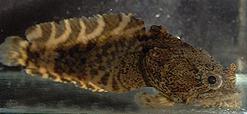| Malacophagy Among Marine Fish | ||||||||||||||||||||||||||||||
| By Harry G. Lee | ||||||||||||||||||||||||||||||
| Most anglers who are unwilling or unable to bestow
upon other persons the labor of eviscerating their catch soon
acquire a familiarity with the digestive tracts of their quarry.
A few curious butchers may note that the stomach and intestines
often enclose a recapitulation of the animal's feeding activities
for many hours before the fateful meal of barbed steel. In the
experience of the writer and several others, mollusks form a
conspicuous portion of the gut contents of certain marine fish
caught hereabouts and elsewhere.
Opsanus tau Malacologists of the last century were already aware that valuable material could be obtained from the digestive tracts of marine fish. New Englanders like Gould, Mighels, and C.B. Adams reported dozens of marine shells, several exclusively from cod and haddock taken off the Grand banks (Gould, 1870) and no doubt provided by Bostonian fishmongers. Even to this day, many deeper water shells, some of uncommon renown, are brought to collectors' cabinets via this untidy but most provenant medium. Nonetheless, it appears that scientists and ambitious collectors alike have plenty to learn about the feeding habits of fish. Information of this sort will aid our understanding of marine ecology and may ultimately reap rewards for our sport and commercial fisheries as well as us mollusk watchers.
Last summer, smitten with characteristic ill fortune while fishing nine miles off St. Augustine, the writer landed a one pound toadfish. Recalling the wealth of shells in John Fatu's batfish, Ogcocephalus sp. (see 5/79 Shell-O-Gram), he stowed this ghastly creature among its more worthy relatives in the shipboard ice chest. A few hours later, amidst guffaws of fellow anglers, a semi-careful dissection was carried out on this ugly (Opsanus tau (Linnaeus)) and produced a small shell collection.
A review of the guts of grunts, mackerel and snapper taken by the more successful members of the party produced no shells at all. Jacksonville Shell Club (JSC) member Charlotte Lloyd has been keeping notes on gut contents of fish taken off Mayport and dissected during the past few years. The following table summarizes her findings:
Except for the trigger fish, these predators were obviously feeding on the bottom. These fish are clearly not as wed to the benthic habitat as are the toad - and batfish, both of which actually lie prone on the substrate almost continually. Nonetheless there are some pleasant surprises on the list, and we can conclude that not all significantly malacophagous fish are bottom-dwellers - or even bottom-feeders. Another JSC member, Germaine Warmke, (with Donald S. Erdman,1963), has reported on the stomach and intestinal contents of bonefish (Albula vulpes Linnaeus) taken from Puerto Rican waters. These fish are well-known to sportsmen and are rapid swimmers doing much of their feeding on shallow Thalassia (turtlegrass) beds. Mollusks comprised 56% of the identifiable contents of 272 fish. Clams accounted for ten times as much volume as did snails. The average fish contained between three and four shells. From 56 fish a total of 24 bivalve and 13 snail species were reported, but most specimens were fragmented. The authors also mentioned earlier work done by others dealing with reef fish in the Marshall Islands, New England haddock, and shallow water fishes of Puerto Rico and the Virgin Islands. Dorothy Raeihle (1979) recently reported that a tautog (Tautoga onilis (Linnaeus)) caught in the vicinity of New York City had behaved similarly to Germaine's bonefishes. It was glutted with fragmented mussels (Mytilus edulis Linnaeus, 1758). In contrast to the two forgoing species' apparent preference for clams over snails, the Brasilian cousin of our local toadfish has a striking appetite for the latter. Henry Ramos Matthews (1968) tells us that the guts of pacamão (Amphichthys cryptocentrus (Valenciennes, 1837)) taken off Fortaleza have produced 84 species of snails vs. only five of clams. The number of fish examined was not stated, but it was probably great. These fish are usually taken by hook from rock bottoms at 12 to 20 fathoms. Propustularia surinamensis (G. Perry, 1811) and other highly-regarded shells appear on Matthews' list. The pacamão produced the first Morum matthewsi Emerson, 1967 (named for its human discoverer) and Bursa pacamoni Matthews and Coelho, 1970 (after its original collector). The most famous source of ex pisce* (out of the fish) shells is undisputedly the musselcracker, Sparodon durbanensis (Castlenau), which occurs off S.E. Africa, where specimens up to 40 lbs. are taken by commercial anglers (Boswell, 1964). The fish come in from the depths often in excess of 300 feet and are a (if not the most) consistent source of such rarities as:
It appears that the pacamão and musselcracker have common traits which account for their usefulness to malacologists and other collectors: (1) sufficiently large to accommodate medium or larger shells (2) no fragmentation of shells with swallowing (oral, pharyngeal, or gizzard) (3) occurrence in deep, inaccessible habitats (4) appetite for mollusks, especially snails (5) amenable to capture by hook and line Our local toad - and batfish certainly qualify on (2) through (5); so think twice before dispatching these "junk fish" to their point of origin if you've had the good fortune to land one! *Pisce is in the ablative case: "ex pisces" is a widely-employed but flagrant error in syntax. Literature Cited: Boswell, H. (1964) South Africa's ex-pisce (sic) shells Hawaiian Shell News 12(5): 1-3, 3 figs. Gould, A.A. (1870) Report on the Invetrebrates of Massachusetts (edited by W.G. Binney) University Press, Cambridge, USA. Matthews H.R. (1968) Mollusks found in the digestive tract of the fish Amphichthys cryptocentrus (Valenciennes, 1837) Proc. Malac. Soc. London 38: 247-250. Raeihle, D. (1979) A collector of miniatures New York Shell Club Notes No. 256 (November): 3-4. Warmke, G.L. and D.S. Erdman (1963) Records of marine mollusks eaten by bonefish in Puerto Rican waters Nautilus 76(4): 115-120. |

